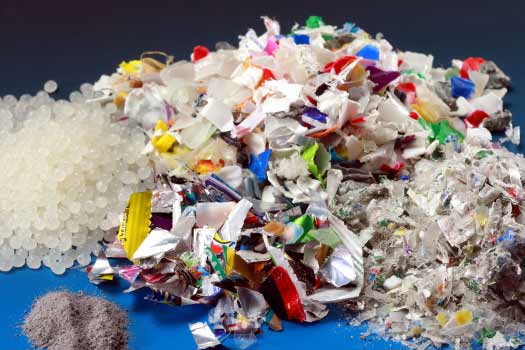Converting packaging waste into high-quality recyclates

Food packaging must be safe and provide a protective function
Plastic multilayer composites are often used to package food in a safe and well protected way. Depending on the requirements of the packaged goods, seven or more layers are combined in a single film. Currently, such plastic packaging either ends up in landfills for disposal or is thermally recycled. Recycling with already industrially established processes is not possible. Approximately two million metric tons of this waste from multilayer food packaging is generated each year throughout Europe. Moreover, EU legislation restricts the use of recyclates in food packaging, as they can contain undesirable substances that may pass into the food.
Making food packaging recyclable
CIRCULAR FoodPack aims to recycle food packaging in a closed circular economy and enable it to be used in direct contact with food. Innovative mono-material packaging with a protective function not inferior to multilayer multi-material packaging is being developed to be recycled and reused, thereby enabling a closed circular economy. Integrating tracers into the packaging systems ensures that food packaging and non-food packaging waste streams can be clearly separated. This reduces the risk of unsuitable substances coming into contact with foodstuffs at an early stage. Furthermore, various processes are used to purify the post-consumer recycled material to minimize odors, colors and other contaminants. The solvent-based recycling process developed at the Fraunhofer Institute for Process Engineering and Packaging IVV uses selective extraction to recover individual target polymers, such as polyethylene, from multilayer packaging. Additives and other foreign substances can be depleted in special purification steps. By combining the treatment processes high-quality recyclates with a high degree of purity will be produced, which can be used in sensitive packaging applications such as food and body care products. A share of >50% of recyclates in the final packaging structures is targeted behind a functional barrier layer to prevent the migration of substances which were introduced non-intentionally. The project is supported by a comprehensive sustainability assessment study taking into account social, environmental and economic impacts, and by an assessment of market and consumer needs.
CIRCULAR FoodPack - mid-term project status
To determine the status quo, approximately 1 metric ton of packaging waste was analyzed across Europe (France, Belgium, Germany) in the first year to investigate factors such as waste management, collection status and the composition of flexible packaging waste. With a rate of more than 80%, non-food packaging dominates the French, Belgian and German PE streams. This corresponds to the similar specification of waste streams by EPR schemes in these three countries. Two of the German streams analyzed contained up to 60% of food packaging. The percentage of multilayer structures as well as polyolefins is still being determined. Furthermore, the researchers found a significant difference in packaging printing, which is considerably higher for food packaging.
In July 2022, researchers tested the integration and function of tracer-based sorting technology on a large scale by mixing 800 kg of packaging waste with tracer-based packaging and then re-sorting it. The tracers mark the packaging according to specific materials or origin, like food. This enables the marked food packaging to be identified by integrating or retrofitting lasers into conventional recycling processes. Initial results demonstrated a sorting purity of over 97% and a sorting efficiency of 90%.
The various processes selected in the project to decontaminate the post-consumer recyclates and minimize odors, colors and other contaminants also showed initial success. The combination of deinking and delamination technologies removed up to 90% of volatile organic compounds (VOCs).
Functional barriers for reusing recyclates in new packaging
Detectable functional barriers as specified in the new Commission Regulation (EU) 2022/1616 must be implemented in order to reuse the recovered recyclates in food packaging. Fraunhofer IVV has therefore developed a screening method for functional barrier layers to prevent the migration of non-approved substances into foodstuffs. To meet the requirement for recyclable mono-materials (single-material solution with >90% mass fraction), thin organic and inorganic coatings are being investigated as potential barrier layers. These have been identified as promising materials and their use will be tested in the further course of the project.
Project term: |
2021 to 2024 |
Project management |
EU, EU Framework Program for Research and Innovation Horizon 2020 |
Project partners: |
|
Website: |
|
Info on the current status of the project: |
 Fraunhofer Institute for Process Engineering and Packaging IVV
Fraunhofer Institute for Process Engineering and Packaging IVV